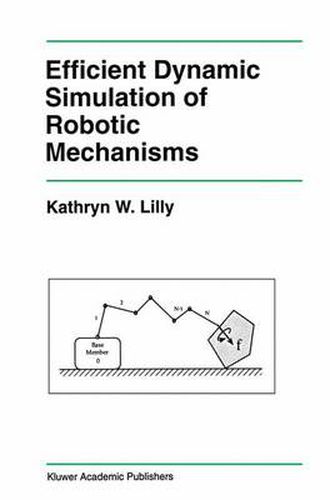Readings Newsletter
Become a Readings Member to make your shopping experience even easier.
Sign in or sign up for free!
You’re not far away from qualifying for FREE standard shipping within Australia
You’ve qualified for FREE standard shipping within Australia
The cart is loading…






This title is printed to order. This book may have been self-published. If so, we cannot guarantee the quality of the content. In the main most books will have gone through the editing process however some may not. We therefore suggest that you be aware of this before ordering this book. If in doubt check either the author or publisher’s details as we are unable to accept any returns unless they are faulty. Please contact us if you have any questions.
Efficient Dynamic Simulation of Robotic Mechanisms presents computationally efficient algorithms for the dynamic simulation of closed-chain robotic systems. In particular, the simulation of single closed chains and simple closed-chain mechanisms is investigated in detail. Single closed chains are common in many applications, including industrial assembly operations, hazardous remediation, and space exploration. Simple closed-chain mechanisms include such familiar configurations as multiple manipulators moving a common load, dexterous hands and multilegged vehicles. The efficient dynamics simulation of these systems is often required for testing an advanced control scheme prior to its implementation, to aid a human operator during remote teleoperation, or to improve system performance. In conjunction with the dynamic simulation algorithms, efficient algorithms are also derived for the computation of the joint space and operational space inertia matrices of a manipulator. The manipulator inertia matrix is a significant components of any robot dynamics formulation and plays an important role in both simulation and control. The efficient computation of the inertia matrix is highly desirable for real-time implementation of robot dynamics algorithms. Several alternate formulations are provided for each inertia matrix. Computational efficiency in the algorithm is achieved by several means, including the development of recursive formulations and the use of efficient spatial transformations and mathematics. All algorithms are derived and presented in a convenient tabular format using a modified form of spatial notation, a six-dimensional vector notation which greatly simplifies the presentation and analysis of multibody dunamics. Basic definitions and fundamental principles required to use and understand this notation are provided. The implementation of the efficient spatial transformations is also discussed. As a means of evaluating effiency, the number of scalar operations (multiplications and addition) required for each algorithm is tabulated after its derivation. Specification of the computational complexity of each algorithm in this manner makes comparison with other algorithms both easy and convenient. The algorithms presented in this work are among the most efficient robot dynamics algorithms available at this time. In addition to computational efficiency,special emphasis is also placed on retaining as much physical insight as possible during algorithm derivation. The algorithms are easy to follow and understand, whether the reader is a robotics novice or a seasoned specialist.
$9.00 standard shipping within Australia
FREE standard shipping within Australia for orders over $100.00
Express & International shipping calculated at checkout
This title is printed to order. This book may have been self-published. If so, we cannot guarantee the quality of the content. In the main most books will have gone through the editing process however some may not. We therefore suggest that you be aware of this before ordering this book. If in doubt check either the author or publisher’s details as we are unable to accept any returns unless they are faulty. Please contact us if you have any questions.
Efficient Dynamic Simulation of Robotic Mechanisms presents computationally efficient algorithms for the dynamic simulation of closed-chain robotic systems. In particular, the simulation of single closed chains and simple closed-chain mechanisms is investigated in detail. Single closed chains are common in many applications, including industrial assembly operations, hazardous remediation, and space exploration. Simple closed-chain mechanisms include such familiar configurations as multiple manipulators moving a common load, dexterous hands and multilegged vehicles. The efficient dynamics simulation of these systems is often required for testing an advanced control scheme prior to its implementation, to aid a human operator during remote teleoperation, or to improve system performance. In conjunction with the dynamic simulation algorithms, efficient algorithms are also derived for the computation of the joint space and operational space inertia matrices of a manipulator. The manipulator inertia matrix is a significant components of any robot dynamics formulation and plays an important role in both simulation and control. The efficient computation of the inertia matrix is highly desirable for real-time implementation of robot dynamics algorithms. Several alternate formulations are provided for each inertia matrix. Computational efficiency in the algorithm is achieved by several means, including the development of recursive formulations and the use of efficient spatial transformations and mathematics. All algorithms are derived and presented in a convenient tabular format using a modified form of spatial notation, a six-dimensional vector notation which greatly simplifies the presentation and analysis of multibody dunamics. Basic definitions and fundamental principles required to use and understand this notation are provided. The implementation of the efficient spatial transformations is also discussed. As a means of evaluating effiency, the number of scalar operations (multiplications and addition) required for each algorithm is tabulated after its derivation. Specification of the computational complexity of each algorithm in this manner makes comparison with other algorithms both easy and convenient. The algorithms presented in this work are among the most efficient robot dynamics algorithms available at this time. In addition to computational efficiency,special emphasis is also placed on retaining as much physical insight as possible during algorithm derivation. The algorithms are easy to follow and understand, whether the reader is a robotics novice or a seasoned specialist.